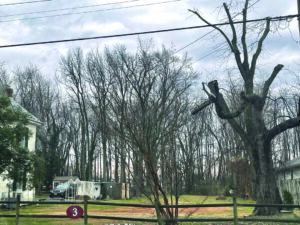
Sometimes, for the health of the tree itself or to avoid damage to property from falling limbs and toppling trunks, the decision must be made to bring it down.
Trees are not only treasured parts of our landscape. These silent sentries become deeply embedded in our world, providing shade, shelter, wildlife habitat, and beauty.
Even more, trees serve as living calendars and, in a way, keepsakes, connecting us through each passing season of our lives, sometimes from generation to generation, from play forts and swings to sweetheart carvings and wedding canopies–so many memorable milestones! Some have literally borne witness to historic events we can only read about.
For all these reasons, when an older tree shows signs of decline, it hits hard.
With beloved pets, we unconsciously know, so somehow accept, that their lifespans are far shorter than our own. At the outset, with each new kitten and puppy we joyfully welcome, we also recognize that one day we’ll have to face saying goodbye.
But trees seem eternal, capable of standing their sacred ground far longer than we mere mortals.
Many have remained rooted for well over a century; we wonder how many more would go on far longer if not for a multitude of dangers, from ravages wrought by weather and climate change to insect destruction, and especially, ever encroaching civilization.
Sometimes, for the health of the tree itself or to avoid damage to property from falling limbs and toppling trunks, the decision must be made to bring it down.
Locally, a variety of regulations regarding tree removal are in place, and a permit from the county Planning and Zoning Office is often required.
Dorchester County’s Historic Preservation District Design Guidelines include the following criteria:
• If a mature tree visible from the public right of way requires removal due to disease or death, it should be so certified by a licensed arborist;
• Removal of trees deemed character defining for the street, located between the plane of the front facade and street curb, and having a caliper/trunk diameter of 12 inches or more, should be submitted for review and guidance to the HPC;
• A Queen Anne’s County zoning official said people can also reach out to his department for a variety of tree maintenance project permits, including vine and vegetation removal, sediment control, as well as guidelines for planting back; and
• To help navigate the many variables involved, The University of Maryland Extension Service offers excellent guidelines on its website pamphlet, “How Do You Decide When to Remove A Tree,” at https://extension.umd.edu/resource/how-do-you-decide-when-remove-tree.
Among the many detailed questions raised and answered are:
• Is it a desirable species?
• How healthy is the tree?
• Is it leaning?
• Is there trunk damage?
• Are all dead branches on one side of the tree? and
• Has there been excavation nearby causing root damage?
When a tree has historic or sentimental value, more expense is justified to salvage it. However, if a tree is losing large branches, it is likely time for it to be replaced, the pamphlet notes.
According to the DNR website, statewide critical area regulations pertain particularly to buffer zones, defined as “the land area immediately adjacent to tidal waters, tidal wetlands, and tributary streams.”
“Removal of healthy trees and vegetation in the Buffer is not permitted solely for the purpose of creating a view. However, trees and shrubs can be pruned and limbed up to create openings that provide a view. The removal of invasive species and vines is permitted and can also improve a view. A Buffer Management Plan can be used for this purpose.”
“It’s tough to accept that not all trees are gonna make it,” noted Andrew Kling, Agent Assocuate for The University of Maryland Extension Service Western Maryland Research and Education Center. “We’re here mainly as educators, helping people find the balance between what’s best for their trees and for them.”
The Extension Service, with support from a dozen conservation and land management partners across the state, helps facilitate a free nationwide informational program, Call Before You Cut, which began in Ohio in 2006.
Maryland landowners can access expert forestry advice by visiting the website callb4ucut.com/maryland and selecting “Request Info,” or by calling 301-432-2767, extension 315.
Dorchester County State Forester Scott Daniels, who has lived in the county for 40 years, knows about the special challenges afflicting trees in the county’s expansive southern region. Faced with ever rising tides, Daniels recommends planting salt tolerant trees.
For now, he noted, there aren’t major issues with “bad” insects, referring to destructive periodic invasions by hordes of Gypsy Moths (now called Sponge Moths), Southern Pine Beetles, and Emerald Ash Borers.
To help keep trees as healthy as possible, “a little fertilizer never hurts,” Daniels added.
Planting in areas that avoid the compacting of roots, such as near driveways and busy foot traffic areas is also not a good idea.
“Trees are alive. Just like pets and people, it’s important to regularly monitor their well being,” Daniels mentioned.
Maryland landowners and their trees have strong support from state agencies in a number of areas, Kling added.
Notably, all tree cutting professionals and arborists working are required to be DNR licensed in order to practice in Maryland. To assist people seeking someone qualified, DNR maintains an online listing.
And, in 2021 the state General Assembly passed a program pledging to plant and maintain 5 million native trees by 2031 (https://mde.maryland.gov/programs/air/climatechange/pages/trees-commission.aspx).
According to the initiative’s website, the program will include workforce development plus ongoing educational and technical assistance.
For more information, visit Maryland Department of Natural Resources’ Urban & Community Forestry page to find the Licensed Tree Expert locator at http://dnrweb.dnrstate.md.us, or call the Forest Service at 410-260-8531.



